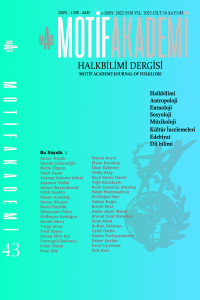SİVAS İLİNDE TELKÂRİ İŞLEMECİLİĞİ VE SON TEMSİLCİLERİNDEN NİYAZİ ARSLANHAN’IN ÇALIŞMALARI
FILIGREE ART IN SİVAS AND NİYAZİ ARSLANHAN'S WORKS ONE OF THE LAST REPRESANTATIVES
Author(s): Fatmagül SAKLAVCISubject(s): Archaeology, Cultural history, Museology & Heritage Studies, Customs / Folklore, Cultural Anthropology / Ethnology
Published by: Motif Halk Oyunları Eğitim ve Öğretim Vakfı
Keywords: Traditional crafts; silver work; filigree; Sivas filigree;
Summary/Abstract: Many archaeological finds have been found, showing that the history of silverwork goes back to BC. The items belonging to various civilizations in Anatolia, prepared with silver craftsmanship, reveal the cultures, socio-economic conditions, lifestyles, tastes and intercultural interaction of the people of that period. Turkish silver working began to spread in Central Asia, the use of gold and silver increased in Anatolia with Islam, and preserved its importance in the Anatolian Seljuk and Ottoman periods. After the Ottomans lost their domination of the Balkan lands, the people living here settled in various parts of Anatolia, such as Sivas, and brought their culture and arts with them. It is known that some of the ancestors of Sivas silver masters were also craftsmen among the immigrants settled in these regions. While the number of silver masters was more than a hundred in Sivas in the 1950s and 1960s, many of them left the profession by going to Istanbul or abroad. Today, there are a few masters dealing with silverwork, one of the professions that are on the verge of disappearing in the province of Sivas. The silver material used for filigree turned into wire by melting the silver taken to the Istanbul Grand Bazaar in the furnaces. Traditional materials such as combs, pliers, double, hooknose, dice trench sets are used to create forms with vav, glitter, drop, shuttle filling techniques. Traditional materials such as combs, pliers, doubles, hooknose, dice heşdek sets are used to create the forms. Parts such as necklaces, rings, bracelets, pens and boxes, which are given their final shape with the help of borax, solder and teneker, are cleaned and polished in the ball and needle cabinet. The art of filigree, which is very troublesome to make in traditional methods, succumbs to technology, the variety in products increases, but the demand decreases due to costs. Our aim in doing this study is to research the history and current status of the arts and professions in Sivas, such as blacksmithing, smithing, stick-making, which succumbed to time and conditions, and to transfer them to future generations by introducing their masters.
Journal: Motif Akademi Halkbilimi Dergisi
- Issue Year: 16/2023
- Issue No: 43
- Page Range: 1429-1449
- Page Count: 21
- Language: Turkish

